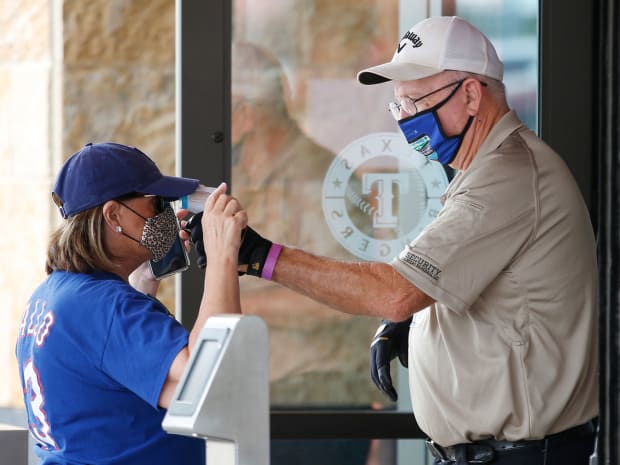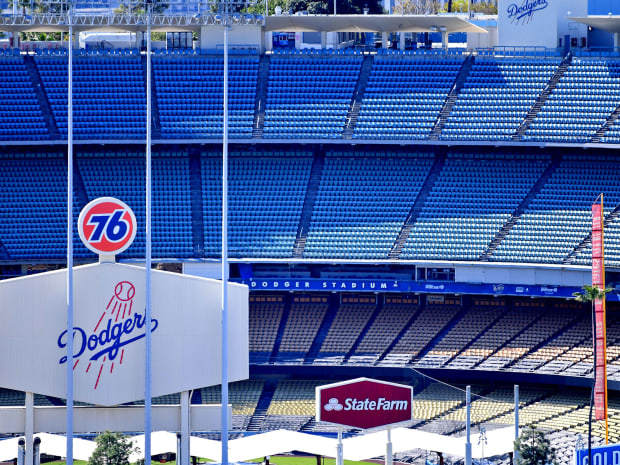MLB teams are playing out of their home parks. Good idea? Epidemiologists aren't even sure.
The announcement that MLB would resume play in July had been out for scarcely half an hour when another story popped on the radar: Three players on the Colorado Rockies had tested positive for the coronavirus.
The second news item did not have a direct effect on the first one. But it did serve as an unfortunate reminder of a key point. The battle for a baseball season did not end when the league finished negotiating. Instead, it’s just getting started, driven by a threat far out of either owners’ or players’ control: COVID-19.
“The virus is not going on a summer vacation,” says Dr. Bill Schaffner, a professor of infectious diseases at Vanderbilt. “It’s out there being transmitted very intensely in many different parts of the country.... I’m more worried now than I was three or four weeks ago.”
MLB's announcement comes just days after the closure of team facilities in Florida and Arizona, prompted by an outbreak at the Phillies’ camp in Clearwater, Fla. The league has tried to address the risk inherent in playing by reimagining baseball with a slew of new processes and regulations. (101 pages’ worth, to be exact, prohibiting everything from spitting to high-fives to shared deodorant.) But MLB’s core strategy here differs from that of the other major leagues that aim to play soon. Instead of operating in a “bubble,” or out of a few hub cities, baseball will play in its usual 30 ballparks. Which comes with questions: Just how much can you limit the spread of the virus with 30 teams playing in 28 cities? Is spreading that risk smarter than keeping it consolidated in one environment? Is this the safest choice, or, simply, a choice?
“If you’re trying to play in two dozen home markets here in the U.S., just based on the level of viral spread that we have, I’m very concerned that some of those will have rampant spread and be exploding at any given time,” says Dr. Zachary Binney, an epidemiologist at Emory University. “And if that’s the case, could your local public health officials shut it down and say you can’t play? Or will you say, it’s too dangerous, we can’t play? Will you get so many cases on your team that you’ll be forced to shut it down? And if that happens, what does that look like in terms of scheduling disruption?”

Away from the ballpark, there are no codified restrictions for players (or managers, or coaches, or trainers, or umpires, or translators, or any of the myriad other people needed to play baseball). The 101-page manual puts it thusly: “MLB will not formally restrict the activities of Covered Individuals when they are away from Club facilities, but will expect the Covered Individuals on each Club to ensure that they all act responsibly. The careless actions of a single individual places the entire team (and their families) at risk, and the Covered Individuals on each Club should agree on their own off-field code of conduct for themselves and their family members to minimize the risk to others.” In other words—unless their teams decide to issue a code of conduct that states otherwise—players can continue to do whatever they want off the field. But, depending on where they are in the country, the level of risk involved in even basic acts could vary significantly.
“The Twins and the Rockies have different public health leaders and different public health perspectives and, quite frankly, are in different places in the coronavirus outbreak right now than the Rangers and the Diamondbacks,” says Dr. Dawn Comstock, a sports epidemiologist at the Colorado School of Public Health. “You’re going to have to deal with different public health mandates.”
Compare this to the other major leagues about to start play. The NBA, WNBA, and MLS will have their bubbles in Florida. The NHL is in the process of picking its two hub cities, and the NWSL will be in Utah. These “bubbles” will see players isolated in one environment for weeks or months, with minimal movement in or out, and all basic needs met inside. Of course, no bubble will be flawless: "That’s an ideal circumstance that may work on Mars,” says Dr. Schaffner. “But it’s unlikely to work in the United States.” It also has potentially serious ramifications for players’ and staffers’ mental health and general well-being. In terms of planning, however, it offers one cohesive environment, operating in one community. That’s significantly different from MLB.
“It’s sort of a pick-your-poison situation,” Dr. Binney says. “You could centralize all the risk. But if that city explodes, then your whole league is in trouble. Or do you want to accept the more dispersed risk, where one of your teams is probably going to be in trouble at any given time, but maybe not all of you will have to shut down?”
MLB has chosen the latter—reportedly with the ability to relocate any team to a neutral site if necessary. This decision came after the league had reportedly considered some variation of a bubble previously. (There was originally talk of a split system for Florida-Arizona-Texas, and, more recently, of one that could work in California.) But there was little interest from players, and even if there had been, baseball would have faced other issues with the construct. Compared to the NBA or WNBA, the rosters here are enormous. Compared to the one-month tournaments of MLS and NWSL, even this abbreviated season feels endless. Had MLB decided to install a bubble—which, again, would still have physical risks, as well as the extreme demands on players’ lives—it would have needed one on a different scale than what sports have seen already.
“It’s a much greater challenge for MLB,” says Dr. Comstock. “Where on earth is big enough? ...It’s a very interesting academic exercise for someone like me to think about how you could do it. But I just don’t think there’s any way it’s truly feasible.”
Which leaves MLB going forward in its various ballparks around the country (and Toronto). The 60-game calendar will be modified to cut down on travel—no cross-country trips, thanks to a division-based schedule—and there will be strict rules around flights and hotels. (On planes, the middle seat will be blocked off, and no one will be allowed to get up except to use the restroom. At hotels, players will not be allowed to swim in the pool or eat in the restaurant, and everyone will carry his own bags to his room.) These measures can limit the spread of the virus. But they're not fail-safe.

“If they’re traveling in a group on a charter plane, and if that group has already been screened and has limited their outside contacts, that’s a good minimization of risk,” says Dr. Jared Baeten, an epidemiologist and vice-dean of the School of Public Health at the University of Washington. “The bigger problem is when it lands. Is every person committed to not slipping out for a pack of gum? Or a beer at the bar next door to the hotel? All of those things will put the whole enterprise at risk. It’s personal responsibility for collective benefit.”
The players will be tested for the virus every other day, per the manual. (The managers, coaches, trainers, and others who physically interact directly with players will be tested “multiple times per week.”) But the Phillies' recent outbreak shows that, even with regular testing, there is still room for the virus to spread quickly.
“That really illustrates the problem with relying on a market-based approach where the players and staff are not sequestered,” Dr. Binney says. “Even in a plan with daily testing, you can still have so many cases that, at some point, you’ll have to shut down just from stuff that happens in the community. A player shares all his contacts with his family, and you know, you can ask them to stay at home, but what’s the adherence going to look like with that? I think it leaves you open to a lot of risk if there’s explosive spread in your area.”
For players who are high-risk—as determined by a team doctor with criteria from the CDC—there will be an opportunity to sit out the season with pay and service time. But there is some level of hazard for everyone, even with a hundred pages of planning, and no system can eliminate that entirely.
“There are still healthy individuals that are either becoming extremely ill or even dying from this disease,” says Dr. Comstock. “Is it worth it to put players’ lives at risk so that we can watch baseball games?”